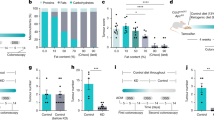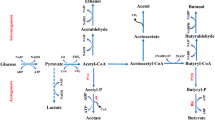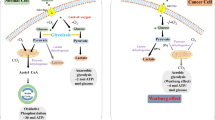Abstract
Purpose: The gut fermentation product of dietary fiber, butyrate, inhibits growth of HT29, an established tumor cell line. It also induces detoxifying enzymes belonging to the glutathione S-transferase family (GSTs), namely hGSTM2, hGSTP1, hGSTA4, but not of hGSTT1 . Here we investigated kinetics of effects in HT29 and compared sensitivities with preneoplastic LT97 colon adenoma cells, to assess mechanisms of colon cancer chemoprevention in two stages of cell transformation. Methods: We determined cell growth after butyrate treatment by quantifying DNA, GST expression by Northern/Western Blotting or biochemical analysis and butyrate consumption by measuring the residual concentrations in the cell culture supernatants. Stability of GST-theta (hGSTT1) mRNA was assessed in HT29 cells after inhibition of transcription with actinomycin D. Results: LT97 adenoma cells consumed twofold more butyrate and were more sensitive to growth inhibition than HT29 (EC501.9 mM and 4.0 mM, respectively). Butyrate did not induce GSTs, but instead reduced hGSTT1 in LT97 and HT29. Conclusions: Butyrate has suppressing-agent activities in human colon cells by inhibiting two survival factors, namely hGSTT1 and cell growth, with LT97 more sensitive than HT29. These findings indicate that butyrate formation in the gut lumen of humans could be protective by reducing survival of transformed colon cells.



Similar content being viewed by others
References
Abrahamse SL, Pool-Zobel BL, Rechkemmer G (1999) Potential of short chain fatty acids to modulate the induction of DNA damage and changes in the intracellular calcium concentration in isolated rat colon cells. Carcinogenesis 20:629–634
Beyer-Sehlmeyer G, Glei M, Hartmann E, Hughes R, Persin C, Bohm V, Rowland I, Schubert R, Jahreis G, Pool-Zobel BL (2003) Butyrate is only one of several growth inhibitors produced during gut flora-mediated fermentation of dietary fibre sources. Br J Nutr 90(6):1057–1070
Bradford MM (1976) A rapid and sensitive method for the quantification of microgram quantities of protein utilizing the principle of protein-dye binding. Anal Biochem 72:248–254
Butzner JD, Parmar R, Bell CJ, Dalal V (1996) Butyrate enema therapy stimulates mucosal repair in experimental colitis in the rat. GUT 38:568–573
Cummings J (1981) Short-chain fatty acids in the human colon. GUT 22:763–779
Cummings JH, Beatty ER, Kingman SM, Bingham SA, Englyst HN (1996) Digestion and physiological properties of resistant starch in the human large bowel. Br J Nutr 75:733–747
Djouzi Z, Andrieux C (1997) Compared effects of three oligosaccharides on metabolism of intestinal microflora in rats inoculated with a human faecal flora. Br J Nutr 78(2):313–324
Ebert MN, Beyer-Sehlmeyer G, Liegibel UM, Kautenburger T, Becker TW, Pool-Zobel BL (2001) Butyrate-induces glutathione S-transferase in human colon cells and protects from genetic damage by 4-hydroxynonenal. Nutr Cancer 41:156–164
Ebert MN, Klinder A, Schäferhenrich A, Peters WHM, Sendt W, Scheele J, Pool-Zobel BL (2003) Expression of Glutathione S-transferases (GST) in human colon cells and inducibility of GSTM2 by butyrate. Carcinogenesis 24:1637–1644
Finnie IA, Dwarakanath AD, Taylor BA, Rhodes JM (1995) Colonic mucin synthesis is increased by sodium butyrate. GUT 36:93–99
Fodde R, Smits R, Clevers H (2001) APC signal transduction and genetic instability in colorectal cancer. Nat Rev Cancer 1:55–67
Fogh J, Trempe X (1975) Human tumor cells in vitro. In: Fogh J (ed) Human tumor cells in vitro. Plenum, New York, pp 115–159
Habig WH, Pabst MJ, Jakoby WB (1974) Glutathione S-transferase. The first enzymatic step in mercapturic acid formation. J Biol Chem 249:7130–7139
Hague A, Paraskeva C (1995) The short-chain fatty acid butyrate induces apoptosis in colorectal tumour cell lines. Eur J Cancer Prev 4:359–364
Hague A, Elder DJE, Hicks DJ, Pareskeva C (1995) Apoptosis in colorectal tumour cells: Induction by the short chain fatty acids butyrate, propionate and acetate and by the bile salt deoxycholate. Int J Cancer 60:400–406
Hague A, Singh B, Paraskeva C (1997) Butyrate acts as a survival factor for colonic epithelial cells: further fuel for the in vivo versus in vitro debate. Gastroenterology 112(3):1036–1040
Hansson LO, Bolton-Grob R, Widersten M, Mannervik B (1999) Structural determinants in domain II of huma glutathione transferase M2-2 govern the characteristic activities with aminochrome, 2-cyano-1,3-dimethyl-1-nitrosoguanidine, and 1,2-dichloro-4-nitrobenzene. Protein Sci 8:2742–2750
Hayes JD, Pulford DJ (1995) The glutathione S-transferase supergene family. regulation of GST* and the contribution of the isoenzymes to cancer chemoprotection and drug resistance. Crit Rev Biochem Mol Biol 30:445–460
Hayes JD, Flanagan JU, Jowsey IR (2005) Glutathione transferases. Annu Rev Pharmacol Toxicol 45:51–88
Johnson IT, Williamson G, Musk SRR (1994) Anticarcinogenic factors in plant foods: a new class of nutrients? Nutr Res Rev 7:175–204
Kensler TW, Helzlsouer KJ (1995) Oltipraz: clinical opportunities for cancer chemoprevention. J Cell Biochem 22(suppl):101–107
Kiessling G, Schneider J, Jahreis G (2002) Long-term consumption of fermented dairy products over 6 months increases HDL colesterol. Eur J Clin Nutr 56:1–7
Kirlin WG, Cai J, DeLong MJ, Patten EJ, Jones DP (1999) Dietary compounds that induce cancer preventive phase 2 enzymes activate apoptosis at comparable doses in HT29 colon carcinoma cells. J Nutr 129:1827–1835
van Lieshout EMM, Peters WHM, Jansen JB (1996) Effect of oltipraz, alpha-tocopherol, betacarotene and phenethylisothiocyanate on rat oesopageal, gastric, colonic and heptatic glutathone, glutathione S-transferase and peroxidase. Carcinogenesis 17:1439–1445
van Lieshout EMM, Bedaf MMG, Pieter M, Ekkel C, Nijhoff WA, Peters WHM (1998) Effects of dietary anticarcinogens on rat gastrointestinal glutathione S-transferase theta 1-1 levels. Carcinogenesis 19:2055–2057
Lupton JR (1995) Butyrate and colonic cytokinetics: differences between in vitro and in vivo studies. Eur J Cancer Prev 4:373–378
Macfarlane GT, Macfarlane S (1997) Human colonic microbiota: ecology, physiology and metabolic potential of intestinal bacteria. Scand J Gastroenterol 32(Suppl 222):3–9
Manus B, Adang RP, Ambergen AW, Bragelmann R, Armbrecht U, Stockbrugger RW (1997) The risk factor profile of recto-sigmoid adenomas: a prospective screening study of 665 patients in a clinical rehabilitation centre. Eur J Cancer Prev 6:38–43
McIntyre A, Gibson PR, Young GP (1993) Butyrate production from dietary fibre and protection against large bowel cancer in a rat model. GUT 34:386–391
Mitelman F (1995) ISCN (1995) An international system for human cytogenetic nomenclature. S.Karger, Basel
Moore WEC, Moore LH (1995) Intestinal floras of populations that have a high risk of colon cancer. Appl Environ Microbiol 61:3202–3207
Mortensen PB, Clausen MR (1996) Short-chain fatty acids in the human colon: relation to gastrointestinal health and disease. Scand J Gastroenterol 31(Suppl 216):132–148
Peters WHM, Boon CEW, Roelofs HMJ, Wobbes T (1992) Expression of drug-metabolizing enzymes and P-170 glycoprotein in colorectal carcinoma and normal mucosa. Gastroenterology 103:448–455
Pool-Zobel BL, Veeriah S, Sauer J, Kautenburger, Kiefer J, Richter KK, Soom M, Woelfl S (2005) Butyrate may enhance toxicological defense in primary, adenoma and tumour colon cancer cells by favourably modulating expression of glutathione S-transferases genes. Carcinogenesis, in press
Richter M, Weiss M, Weinberger I, Furstenberger G, Marian B (2001) Growth inhibition and induction of apoptosis in colorectal tumor cells by cyclooxygenase inhibitors. Carcinogenesis 22(1):17
Richter M, Jurek D, Wrba F, Kaserer K, Wurzer G, Karner-Hanusch J, Marian B (2002) Cells obtained from colorectal microadenomas mirror early premalignant growth patterns in vitro. Eur J Cancer 38(14):1937–1945
Roediger WEW (1989) The utilisation of nutrients by isolated epithelial cells of the rat colon. Gastroenterology 83:424–429
Rosignoli P, Fabiani R, De Bartolomeo a, Spinozzi F, Agea E, Pelli MA, Morozzi G (2001) Protective activity of butyrate on hydrogen peroxide-induced DNA damage in isolated human colonocytes and HT29 tumour cells. Carcinogenesis 22:1675–1680
Schaeferhenrich A, Beyer-Sehlmeyer G, Festag G, Kuechler A, Haag N, Weise A, Liehr T, Claussen U, Marian B, Sendt W, Scheele J, Pool-Zobel BL (2003) Human adenoma cells are highly susceptible to the genotoxic action of 4-hydroxy-2-nonenal. Mutat Res 9496:1–14
Scheppach W, Bartram HP, Richter A, Richter F, Liepold H, Dusel G, Hofstetter G, Röthlein J, Kasper H (1992) Effect of short-chain fatty acids on the human colonic mucosa in vitro. JPEN J Parenter Enteral Nutr 16:43–48
Stein J, Schroeder O, Bonk M, Oremek G, Lorenz M, Caspary WF (1996) Induction of glutathione-S-transferase-pi by short-chain fatty acids in the intestinal cell line Caco-2. Eur J Clin Invest 26:84–87
Stoecklin G, Colombi M, Raineri I, Leuenberger S, Mallaun M, Schmidlin M, Gross B, Lu M, Kitamura T, Moroni C (2002) Functional cloning of BRF1, a regulator of ARE-dependent mRNA turnover. Embo J 21(17):4709–4718
Thellin O, Zorzi W, Lakaye B, De Borman B, Coumans B, Hennen G, Grisar T, Igout A, Heinen E (1999) Housekeeping genes as internal standards: use and limits. J Biotechnol 75(2-3):291–295
Treptow-van Lishaut S, Rechkemmer G, Rowland IR, Dolara P, Pool-Zobel BL (1999) The carbohydrate crystalean and colonic microflora modulate expression of glutathione S-transferase subunits in colon of rats. Eur J Nutr 38:76–83
Wang JS, Shen X, He X, Zhu YR, Zhang BC, Wang JB, Qian GS, Kuang SY, Zarba A, Egner PA, Jacobson LP, Munoz A, Helzlsouer KJ, Groopman JD, Kensler TW (1999) Protective Alterations in Phase 1 and 2 Metabolism of Aflatoxin B1 by Oltipraz in Residents of Qidong, People’s Republic of China. J Natl Cancer Inst 91:347–354
Wattenberg LW (1992) Inhibition of carcinogenesis by minor dietary constituents. Cancer Res 52(Suppl):2085s–2091s
Zimniak P, Nanduri B, Pikula S, Bandorowicz-Pikula J, Singhal SS, Strivastava SK, Awasthi S, Awasthi YC (1994) Naturally occurring human glutathione S-transferase GSTP1–1 isoforms with isoleucine and valine in position 104 differs in enzymic properties. Eur J Biochem 224:27566–27573
Acknowledgements
We gratefully acknowledge the excellent technical assistance by Ms. Esther Hartmann and Ms. Nadine Knoll. We thank Professor Dr. Gerhard Jahreis and Peter Möckel of the Department of Physiology of Nutrition in Jena for analyzing the short chain fatty acids in the cell culture supernatants. We are grateful to Dr. Rosalie Elespuru for valuable discussion and editorial comments. Parts of this work have been carried out with financial support of the Deutsche Krebshilfe (10-1572-Po-1), the Bundesministerium für Ernährung, Landwirtschaft und Forsten (99-HS-039) and the Deutsche Forschungsgemeinschaft (PO 284/8-1).
Author information
Authors and Affiliations
Corresponding author
Rights and permissions
About this article
Cite this article
Kautenburger, T., Beyer-Sehlmeyer, G., Festag, G. et al. The gut fermentation product butyrate, a chemopreventive agent, suppresses glutathione S-transferase theta (hGSTT1) and cell growth more in human colon adenoma (LT97) than tumor (HT29) cells. J Cancer Res Clin Oncol 131, 692–700 (2005). https://doi.org/10.1007/s00432-005-0013-4
Received:
Accepted:
Published:
Issue Date:
DOI: https://doi.org/10.1007/s00432-005-0013-4




